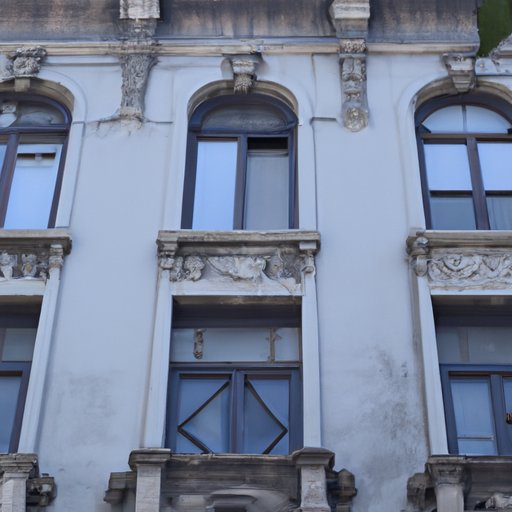Introduction
The facade of a building is one of its most important features. It serves as an essential element of the overall architectural design, while also providing a range of practical functions. But what exactly is a facade? This article will explore the definition and history of facades in architecture, their impact on building functionality and urban development, and their role as a tool for creative expression. It will also discuss how to utilize facades in sustainable architecture.

Overview of Facades in Architecture
A facade is defined as the external face of a building, typically the front or side facing outward. It is responsible for protecting the interior from the elements and providing insulation from outside noise and temperature changes. The facade is also a key component of the overall aesthetic of a building, as it is often the first thing that people see when they approach it. Historically, facades were made from stone, brick, wood, or stucco, but today there are many more materials available for use.
Deconstructing the Facade: A History of Design Evolution
The earliest known examples of facades date back to Ancient Greece, where they were often adorned with decorative details such as columns, pediments, and sculptures. In the Middle Ages, facades were primarily made from stone and featured pointed arches and stained glass windows. During the Renaissance, facades became more elaborate, featuring decorative details such as pilasters, cornices, and balustrades. In the Baroque period, facades were often ornate and over-the-top, with the use of dramatic curves and exaggerated forms.
In the 19th century, the Industrial Revolution brought about a shift in the design of facades. New materials such as cast iron, steel, and concrete allowed for the construction of taller buildings with more complex designs. In the 20th century, modernism and postmodernism saw the emergence of sleek, minimalist facades that utilized clean lines and geometric shapes. Today, facades are often designed with sustainability in mind, utilizing energy-efficient materials and green technologies.
Exploring the Impact of Facades on Building Functionality
Facades play an important role in the structural integrity of a building. They provide protection from the elements and help to maintain the temperature and humidity levels inside the building. Facades can also be used to reduce energy consumption by using materials that are better at reflecting or absorbing heat, or by incorporating passive design strategies such as shading and natural ventilation.
Facades can also play a role in the safety and security of a building. They may incorporate features such as security cameras, motion sensors, and reinforced glass to deter potential intruders. In addition, facades can be designed to withstand extreme weather conditions such as high winds, heavy rains, and extreme temperatures.
Examining the Role of Facades in Urban Development
Facades have a significant impact on the overall look and feel of a city. They can be used to create visually appealing streetscapes, enhance safety and security, and even reflect the local culture and history. Facades can also be used to unify a city’s skyline, creating a cohesive image that reflects the city’s identity.

Investigating Facades as a Tool for Creative Expression
Facades can also be used as a tool for creative expression. Architects and designers often use facades to personalize buildings and make them stand out from the crowd. They can achieve this through the use of bold colors, innovative materials, and unique textures. Common materials used in facade design include stone, brick, wood, metal, glass, and ceramic tiles.

How to Utilize Facades in Sustainable Architecture
Facades can be an integral part of sustainable architecture. Passive design strategies such as shading, natural ventilation, and orientation can be incorporated into the design of facades to reduce energy consumption. Green technologies such as photovoltaic panels and solar water heating systems can also be used to generate renewable energy and reduce carbon emissions.
Conclusion
Facades are an essential element of architectural design, playing an important role in the structural integrity, energy efficiency, and aesthetic appeal of a building. They can also be used to reflect the local culture and history, enhance safety and security, and serve as a tool for creative expression. Furthermore, they can be incorporated into sustainable architecture through the use of passive design strategies and green technologies. Ultimately, facades can have a profound impact on the overall look and feel of a city.
(Note: Is this article not meeting your expectations? Do you have knowledge or insights to share? Unlock new opportunities and expand your reach by joining our authors team. Click Registration to join us and share your expertise with our readers.)
